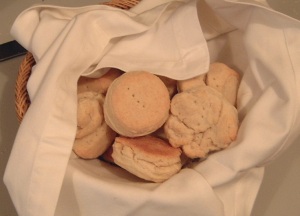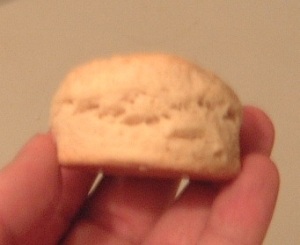
Mrs. Alfred Anson's Hot Buttered Biscuits, straight from the pages of Elsie de Wolfe's Recipes for Successful Dining. Try to ignore the lumpy example at the right. The perfection of the center biscuit is what the recipe actually ends up producing.
The 1934 cookery book Elsie de Wolfe’s Recipes for Successful Dining is a sort of Social Register for the kitchen, since its pages incorporate numerous dishes from the American interior decorator’s Café Society friends. Even the most humble recipes can have a grand provenance, such as Hot Buttered Biscuits, courtesy of a Paris-based hostess, the Honourable Mrs Alfred Anson.
An American general’s daughter who married into a Cincinnati real-estate fortune, Lela Alexander Emery Anson (1870-1953) was best known as the mother of two glamorous heiresses: Lela Emery and her younger sister Audrey. The latter sparked headlines in 1926 by becoming the morganatic wife of Grand Duke Dmitri Pavlovich of Russia, Emperor Nicholas II’s cousin, a dashing Champagne salesman who famously took part in the murder of the monk Rasputin. Lela, for her part, scored a Scottish military officer and later the 7th and last Duc de Talleyrand, eventually setting up housekeeping in Edith Wharton’s former country house, Pavillon Colombe. Before these young women embarked on their marital alliances, however, their widowed mother captured the son of a British earl as her second spouse and made a name as a transatlantic hostess—and presumably delighted family and friends at her homes in New York City, Paris, Bar Harbor, Palm Beach, and Biarritz with her hot buttered biscuits. She evidently had philanthropic interests as well, giving the Metropolitan Museum of Art its first 18th-century French room in 1945.

Mrs. Anson's Hot Buttered Biscuits, hot from the oven. As you can see the eight biscuits I cut first are perfect; the biscuits cut from the combined trimmings are a bit awkward in looks.
Made with lard and about two inches in diameter—we couldn’t find the small round biscuit cutter the recipe specifies so used Catherine’s silver christening cup instead—Lela Anson’s biscuits possess all the standard classic properties. They rise swiftly and split almost on their own in the oven, have a delicately powdery crust, and a moist tender interior made even more delectable thanks to an unusual direction: the dough is meant to be buttered before it is rolled. They are also incredibly pretty, at least the first batch was. After cutting out eight perfect biscuits I combined the trimmings left over to stretch the recipe but the results were a bit lumpen.
“Good old-fashion biscuits are a lost art,” my husband said, reaching for another, adding, “They are the best I ever had, even better than my mother’s.” Our eight-year-old daughter concurred, munching two in rapid succession. “It was soft when I chewed it,” she observed after downing the initial one. “It has the right taste and a nice texture.” In the recipe below our adaptations/comments are placed in brackets.
We would like to thank Josh Kilmer-Purcell and Dr. Brent Ridge of Beekman 1802 for providing the home-rendered lard.
HOT BUTTERED BISCUITS
Recipe by The Hon. Mrs. Alfred Anson, Paris, France
SOURCE: Elsie de Wolfe’s Recipes For Successful Dining
MAKES 12 TO 14 BISCUITS
INGREDIENTS
1 cup milk and [heavy] cream mixed
1/2 cup lard [softened]
2 tablespoons butter [softened]
2-3/4 cups [all-purpose] flour
2-1/2 teaspoons baking powder
1 teaspoon [sea] salt
DIRECTIONS
Mix butter, lard, salt, and baking powder well with fingers. [Have a spatula handy to scrap the lard mixture off your fingers back into the bowl.] Add milk and, last, all but a little of the flour. Do not touch with hands. [Use a wood spoon to mix everything as thoroughly as you can.] Sift biscuit board with flour, place dough on it, and pat as you do pastry. [This means patting, folding into thirds, and gently pressing into a thick rectangle. Do this a couple of times.] Butter [the side facing up] with 1 teaspoon butter and roll with pin. Turn to other side, pat with fingers, and add flour not used. The dough should be about 1 inch thick. Cut with biscuit cutter (small) and prick with fork. [Combine dough trimmings left over and cut more biscuits if you wish, though these will likely not be as pretty as the first batch.] Bake in a very hot [425-degree Fahrenheit] oven [for 10 to 12 minutes, until very lightly browned.] Split, butter, and serve at once.

Wonderfull! I never taste such biscuits, but I absolutly believe your husband and I’ll try to make the same as soon as possible. What do you think if a add 2 or 3 tablespoon of old cheese like comté or beaufort? crazy or good idea?
I think that would be a great addition; let me know how it tastes!
I am nuts for a cousin of this recipe, “cream biscuits,” as James Beard called them. They are one of life’s finest moments. His recipe (handed down by the Chinese cook who worked for his family when Beard was a child, I swear) uses heavy cream but no lard, and is otherwise similar in its components.
They are as good with a meal as they are when used for the underpinnings of strawberry shortcake. Thanks for reminding me.
Strawberry shortcake?! I’m going to give Beard’s biscuits a whirl! Thanks!
These would be perfect on a snowy morning! They look marvelous.
I’m going to make them again this week-end.
If one didn’t know better, one might just think Elsie was a Southerner!
Or that Mrs Anson was!
I, too, noticed the similarity to the JB biscuits. Several years ago, I had an epiphany, when deciding whether to use heavy cream or PLUGRA. I said, why not both? I’ve never looked back. I made these biscuits for my husband’s staff yesterday. On a cold, snowy day warm biscuits and raspberry jam suddenly appeared. One woman cried. I rest my case.
Okay, I’ve never had anybody weep over biscuits. You’ve got me beat!
Ok–we were expecting to see a basket of these on our doorstep. We live just over the hill, for goodness sake!
Well, done. They look just like momma use to make
Aesthete! You left out the third, untitled, Emery daughter–Alexandra, who married Benjamin Moore, and lived to a ripe old age in her glorious moated house at Muttontown, Chelsea, designed by Delano & Aldrich.
Mrs. Anson’s pile at Bar Harbor, ‘The Turrets’, now a college administration building, was a grim old granite pile, designed by Emily Post’s father Bruce Price, and inside as un-Elsie de Wolfe as it gets.
Oh, I didn’t leave out Alexandra for spite or anything like that. She just wasn’t as famous as her sisters, so I didn’t feel right saying that Mrs Anson was “famous” for being her mother too. On the other hand, Alexandra had the best houses of the bunch, especially that house in Muttontown, the beautiful Chelsea. I long to visit it. A moated house! That’s a dream of mine, and that one is particularly beautiful.